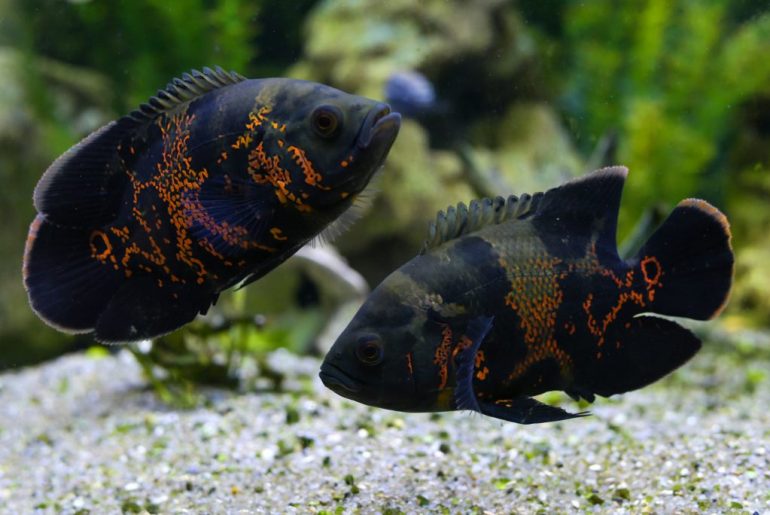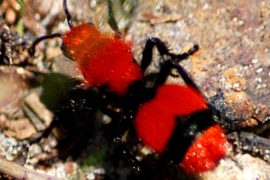There are some freshwater fish species on the market that grow relatively large. For example, peacock cichlids (Astronotus ocellatus) are almost always available in pet stores and usually grow to around 25 cm long, but the fishing record is 45.7 cm and 1.6 kg in weight. So Oskars actually belong more in the “edible fish” category. But they are gorgeously colored and only get more beautiful the bigger and older they are. In addition, large fish develop a strong personality and develop a personal relationship with the keeper. But is it ethically justifiable to keep such large fish in the aquarium?
For laypersons in animal husbandry, the loss of freedom for the animals kept – and this primarily means freedom of movement – appears problematic. The quality of animal husbandry is therefore judged very strongly by laypersons on how large the enclosure is for the respective animal; in the case of fish keeping according to the size of the aquarium. The prevailing opinion is that an enclosure/aquarium that is too large cannot exist at all, that an animal feels better the less it has the feeling of being locked up.
Wild caught from Brazil. Even adult wild-caught fish quickly adapt to the aquarium.
From a scientific point of view, this view could not be more wrong. Animal psychologists and experienced keepers know that an animal never feels locked in because it is mentally incapable of comprehending its situation. Freedom and captivity – these terms do not exist in the animal world, they are exclusively human ideas. For an Oscar, the vastness of the Amazon is completely meaningless. As a cichlid, it has its territory, the size of which mainly depends on the available food, and it usually does not leave this territory.
While no aquarium, however large, can imitate the vastness of nature, that vastness is in fact meaningless to the fish that live there, so there is no need to imitate it.
In the case of fish, undue restriction of movement simply ends in death, and death occurs very quickly in such a case. Anyone who unreasonably tries to pen a fish species that has a great urge to move into an aquarium that is too small, in which it cannot live out this urge to move, will quickly regret it.
But how big does an aquarium have to be to avoid this situation? There are neither lower nor upper limits that can be sensibly named. Vessels with a volume of less than 1 liter can be used as rearing containers for fish larvae, and even aquariums with a volume of several cubic meters can be too small for young animals of certain species that are only a few centimeters long if they do not have certain structural properties that allow these animals the existence of an unlimited Pretend swimming distance.
Anchovies know no limits. Although they are small, they need a huge, specialized tank with curved panes where the fish feel like they can swim straight ahead indefinitely.
However, if you disregard such special cases, you can still set up very good rules of thumb. An open water fish of the species usually kept in aquariums – specifically: barbs, tetras, free-swimming catfish, etc., will never be harmed if the aquarium is about 10x the body length and 5x deep and high. So if you have a meter tank, the final size of the fish kept in it should not exceed 10 cm. For calm, less active animals, such as many cichlids, these dimensions can be halved again. An approximately 30 cm long Oskar is still in good hands in an aquarium of 150 x 50 x 50 cm. He will not get any health problems, either physical or mental, in an aquarium of this size; Of course, it is assumed that the aquarium meets the requirements of an Oscar from a technical point of view (filtration, equipment, etc.). It should be noted that the metabolism of small, growing fish is significantly higher than the metabolism of a full-grown Oskar.
It is therefore quite possible to keep comparatively large fish in your home aquarium and enjoy them, because they are really great animals!
Overall, large cichlids from South America are not necessarily popular aquarium fish in Central Europe. Apart from their body size, they like to dig, regard aquatic plants as part of their diet and make it clear to everyone in the aquarium at breeding time who is the boss in the ring. That’s why most aquarists prefer to see the impressive fellows at the zoo rather than at home. However, Oskars always find a buyer.
Adult wild-colored offspring Oscar, Astronotus ocellatus. The spots in the area of the dorsal fin are typical of the species.
The strange name “Oskar” or “Oscar” has become internationally accepted for this cichlid, in German the fish is called peacock-eye cichlid.
Not all wild animals are particularly colorful. This is a specimen from the Rio Branco in Brazil.
Why is the Oscar called Oscar? To be honest, you don’t know for sure. But what is certain is that the name originated in the USA. In 1936 an article by E.W. Clarke on Astrontus appeared in the journal “The Aquarium”. Clarke owned a couple named Lena and Oscar. In 1949, Gene Wolfsheimer reported in The Aquarium Journal that aquarists in California referred to Astronotus cichlids as Oscars (Wayne Leibel, Aquarium USA Annual 2001). But it is also conceivable that the word “Oscar” is a corruption of the scientific name (i.e. Astronotus) or the Tupi word for all possible larger cichlids “Acara”. Tupi is the language of the people who originally lived in Brazil before the arrival of Europeans in America.
Adult Oscar, tomboy from Colombia. This species is scientifically undescribed.
Astronotus originally came from South America. They live in the great rivers of the Paraguay, the Amazon and the Orinoco region as well as on the Guyana shield. Everywhere they are coveted and popular food fish. No one knows how many species of Astronotus there really are. The genus is, as the saying goes, in great need of revision. Only two species are generally recognized scientifically, A. ocellatus and A. crassipinnis, but a total of seven species have been described in the past. Most are now considered synonymous with A. ocellatus, but this is certainly wrong, at least for some.
The first Oscars were exported to Europe in 1929. Due to their relative undemanding nature and beautiful coloring, they were among the preferred large cichlids brought from South America. One shouldn’t forget that imports used to be done by ship and the animals were usually brought along by seafarers as a part-time job. This means that the fish were on their way from Brazil for 3-4 weeks, often longer, in so-called fish cans. Although one should not underestimate the know-how of the fish transporters of the time, the fish had to have a certain robustness. On the other hand, the successful export of discus was already successful back then…
Young Oskars have a completely different coloring. This is a tomboy from Colombia.
As discussed above, peacock cichlids are among the largest of the commercially available aquarium fish and can (!) reach a length of over 40 cm. Although this is an exceptional size, it can occur in ancient animals in giant tanks. Almost all animals on the market are offspring from Southeast Asia. Wild catches are only very rarely offered and are then always marked as such.
If you have an aquarium with an edge length of 150 to 200 cm, you should definitely keep Oscars in it. In fact, these animals are extremely trusting and joyful animals. In addition, they become more beautiful with every centimeter they grow. In smaller aquariums, however, they often cause trouble, since Oscars are cichlids and defend an individual area quite energetically. Since Astronotus quickly grow to a length of 15-20 cm even in smaller aquaria, a meter tank is not too small for a single Oscar, but no other fish may live in it. That’s why you should rather refrain from buying peacock cichlids if you don’t have a really large aquarium.
Oscars are open breeders, so they spawn on stones or roots etc. and form a parent family, males and females take care of the eggs and young fish equally – often more than 1,000 per brood! It is difficult to tell the sexes apart (females stay smaller and have a more pointed head profile), but it is best to find a pair yourself from a troop of young fish.
There is a good reason why Oscars are not usually bred in Germany. By the time the voracious brood has been sold to market size, the animals have already cost more in labor time, electricity and water (not to mention the food) than they bring in. But when rare wild catches come in – such as the spectacular zebra Oscar – things look different, then the ambition of the real aquarist is aroused and the pecuniary questions move into the background!
Are Oscar fish easy to care for?
Oscar Fish (also known as Velvet Cichlids) are not the easiest fish to care for, so we only recommend them to aquarists who have a bit of experience under their belts. Knowing how to care for Oscar Fish properly will open up a new world of opportunities for you to keep other Cichlids in the future.
How do I keep my Oscar fish tank clean?
Oscars are very messy fish, so fish tank maintenance is paramount. Perform your weekly 10-15% water changes, so that your Oscar always has clean water and the waste that is not processed by the aquarium filter is removed.
Do Oscar fish need to eat everyday?
Generally, small fish need to feed at least twice daily, and juvenile oscars are no exception. I tend to only feed baby oscars until their bellies are slightly distended; that is called feeding satiation. Try and vary the foods a bit, even on a daily basis.
What can I feed my Oscar fish?
Oscar fish are omnivores, which means they need meat as well as a vegetable to survive. In the wild, Oscars eat mostly insects, crustaceans like shrimp, and water plants, so they are the primary ingredients you want to look for in your food. High-quality cichlid flakes and pellets are the best foods to feed your Oscar.
Can Oscars eat bananas?
Common fruits given to oscars include bananas, cantaloupe, oranges and watermelon. Make sure if you feed fruit, you remove any seeds before feeding. Some oscar owners may also feed them bread, which will not harm your fish but will not add anything nutritious to his diet.
Can you put 2 Oscars in the same tank?
Yes, you can easily keep two Oscar Fish in the same tank. But as Oscar Fish can get pretty large you will require to keep them in a large tank. For two Oscars, ideally, you should keep them in at least 75 gallon tank. If you are going to keep Juvenile Oscars then you can keep them in smaller tank.
Do Oscars need air pump?
Do Oscar fish like current? In the wild, Oscar fish mostly found in the Amazon basin in the areas where there is a strong current. So Oscar fish like current and your filter should be able to produce strong current in your tank. And you don’t need any air pump just to produce strong current.
How often do you feed Oscar fish?
Oscars are omnivores but primarily eat meaty food like insects, fish and crustaceans. The staple food in an oscar’s diet are cichlid pellets. Great supplements consist of good quality live food (like feeder fish, shrimp or meal worms) or frozen food. It’s best to feed oscars 4 times per week.
Can you over feed Oscar fish?
Baby oscar fish are voracious eaters and- like any baby- can seem to be hungry all the time. But even if they pull the puppy eyes out, you should still limit the amount of food you give them as overfeeding can make them sick.
How do you tell if your Oscar is a boy or girl?
Do Oscar fish recognize their owners?
Yes, oscar fish recognize their owners. Oscar fish are known as water dogs, mainly due to how they resemble puppies as juveniles, but also because they are very intelligent and affectionate like dogs. You’ll know your oscar fish recognize you as their owner when they swim faster when you’re nearby.
How many Oscars can I keep in one tank?
So, how many Oscars in a 125-gallon tank can you keep? An Oscar fish needs between 55 and 75 gallons of tank space to be happy, with each additional Oscar requiring an additional 30 gallons. Therefore, you could house 2 Oscars in a 125 gallon tank.





